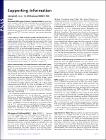| dc.contributor.author | Humphries, Marian | en |
| dc.contributor.author | Campbell, Matthew | en |
| dc.contributor.author | Gobbo, Oliviero | en |
| dc.contributor.author | Farrar, Gwyneth | en |
| dc.contributor.author | Humphries, Peter | en |
| dc.contributor.author | Kerskens, Christian | en |
| dc.date.accessioned | 2009-10-13T18:47:29Z | |
| dc.date.available | 2009-10-13T18:47:29Z | |
| dc.date.issued | 2009 | en |
| dc.date.submitted | 2009 | en |
| dc.identifier.citation | Matthew Campbell, Anh T. H. Nguyen, Anna-Sophia Kiang, Lawrence C. S. Tam, Oliviero L. Gobbo, Christian Kerskens, Sorcha Ni Dhubhghaill, Marian M. Humphries, G.-Jane Farrar, Paul F. Kenna and Peter Humphries, An experimental platform for systemic drug delivery to the retina, Proceedings of the National Academy of Sciences of the United States, 106, 42, 2009, 17817 - 17822 | en |
| dc.identifier.other | Y | en |
| dc.identifier.uri | http://hdl.handle.net/2262/33886 | |
| dc.description | PUBLISHED | en |
| dc.description.abstract | Degenerative retinopathies, including age-related macular degeneration, diabetic retinopathy, and hereditary retinal disorders?major causes of world blindness?are potentially treatable by using low-molecular weight neuroprotective, antiapoptotic, or antineovascular drugs. These agents are, however, not in current systemic use owing to, among other factors, their inability to passively diffuse across the microvasculature of the retina because of the presence of the inner blood?retina barrier (iBRB). Moreover, preclinical assessment of the efficacies of new formulations in the treatment of such conditions is similarly compromised. We describe here an experimental process for RNAi-mediated, size-selective, transient, and reversible modulation of the iBRB in mice to molecules up to 800 Da by suppression of transcripts encoding claudin-5, a protein component of the tight junctions of the inner retinal vasculature. MRI produced no evidence indicative of brain or retinal edema, and the process resulted in minimal disturbance of global transcriptional patterns analyzed in neuronal tissue. We show that visual function can be improved in IMPDH1?/? mice, a model of autosomal recessive retinitis pigmentosa, and that the rate of photoreceptor cell death can be reduced in a model of light-induced retinal degeneration by systemic drug delivery after reversible barrier opening. These findings provide a platform for high-throughput drug screening in models of retinal degeneration, and they ultimately could result in the development of a novel ?humanized? approach to therapy for conditions with little or no current forms of treatment. | en |
| dc.description.sponsorship | The Ocular Genetics Unit at TCD is supported by Science Foundation
Ireland,TheWellcomeTrust,EuropeanVision Institute, EVI-Genoret Grant
LSHG-CT-2005-512036, Fighting Blindness Ireland, and Enterprise Ireland. | en |
| dc.format.extent | 17817 | en |
| dc.format.extent | 17822 | en |
| dc.format.mimetype | application/pdf | |
| dc.format.mimetype | application/pdf | |
| dc.format.mimetype | application/vnd.ms-excel | |
| dc.format.mimetype | application/vnd.ms-excel | |
| dc.language.iso | en | en |
| dc.relation.ispartofseries | Proceedings of the National Academy of Sciences of the United States | en |
| dc.relation.ispartofseries | 106 | en |
| dc.relation.ispartofseries | 42 | en |
| dc.rights | Y | en |
| dc.subject | blood?retina barrier retinitis pigmentosa RNAi tight junctions claudin-5 | en |
| dc.title | An experimental platform for systemic drug delivery to the retina | en |
| dc.type | Journal Article | en |
| dc.type.supercollection | scholarly_publications | en |
| dc.type.supercollection | refereed_publications | en |
| dc.identifier.peoplefinderurl | http://people.tcd.ie/campbem2 | en |
| dc.identifier.peoplefinderurl | http://people.tcd.ie/mhumphri | en |
| dc.identifier.peoplefinderurl | http://people.tcd.ie/kerskenc | en |
| dc.identifier.peoplefinderurl | http://people.tcd.ie/gjfarrar | en |
| dc.identifier.peoplefinderurl | http://people.tcd.ie/phumphrs | en |
| dc.identifier.peoplefinderurl | http://people.tcd.ie/ogobbo | en |
| dc.identifier.rssinternalid | 61863 | en |
| dc.identifier.doi | http://dx.doi.org/10.1073/pnas.0908561106 | en |
| dc.subject.TCDTheme | Genes & Society | en |
| dc.identifier.rssuri | http://dx.doi.org/10.1073/pnas.0908561106 | |





